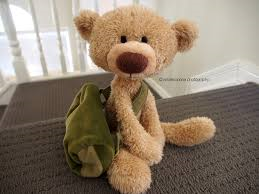
Gund’s Bears, Etc.
The Gund Manufacturing Co. got its start in 1898 in Norwalk, Connecticut – before the teddy bear was even born. When the company was first founded it made innovative toys and novelties to sell in New York City. That makes Gund the oldest manufacturer of soft toys in the United States. And one of the earliest (next to Ideal) American companies to make teddy bears, beginning in 1906. And its bears were truly soft, suitable for hearty hugs from loving children.
Founded by German immigrant Adolph Gund, who was also an inventor, the company received numerous patents for mechanisms that created movement in its toys. An innovator, Gund also created many toy company industry standards for such things as safety and how the toys were actually made.
Gund’s first motto was “GEE,” which it used in advertising until the late 1920’s.
Jacob Swedlin, a Russian émigré, joined Gund in 1909. He had a passion for stuffed toys, a passion that along with hard work brought him to the attention of Adolph Gund. Before long, Swedlin was being trained as one of the toy makers. Eventually he became Gund’s personal assistant, learning the ins and outs of the entire company.
Then, when Gund retired in 1925 with no children, he sold the company to Swedlin for the nominal sum of $1,500 ($20,500 in today’s dollars). Swedlin brought his brothers Abe and John into the company, which was now J. Swedlin, Inc., although it kept “Gund” as its trademark.
The company prospered under the Swedlin brothers and soon began to expand into ever larger quarters in New York City, where it had first moved in the early 1900’s. It continued its lines of teddy bears, but also grew its toy-making interests. And it was their toys that drew most of the attention, sometimes outshining the teddy bears.
Gund was the first company to take advantage of the licensing of popular cartoon characters, including making such figures as Mickey Mouse into soft toys.
In an effort to support the war effort during World War II, Gund made a bear dressed in an Army uniform with a human face that looked a lot like Rosie the Riveter to help sell war bonds.
Gund attracted a lot of attention in 1948 when it won the right to produce toys from Walt Disney Company’s animated cartoons and films, including such well-loved bears as Winnie the Pooh. The license deal made Gund a household name as any store that sold Disney toys bought them from Gund. And Winnie the Pooh was a definite favorite.
Gund also formed licensing arrangements with Hanna Barbera, producing a soft toy version of many of their cartoon characters, including the popular Yogi Bear. Yogi Bear, thought to have been named after New York Yankee great Yogi Berra, was immediately popular when he appeared in TV cartoons beginning in 1958.
Gund continued to be an innovator and was among the first U.S. toy companies to produce toys with vinyl faces. Gund also took full advantage of the popularity of pandas Ling-Ling and Hsing-Hsing’s coming to the U.S. from China in 1972 to lead the field in producing toy pandas.
The Gund logo has changed several times over the years. Today the logo is a white teddy bear, the top of its head visible only in outline in the word “Gund” in red letters and by its black eyes and nose. Its motto, “Gotta Getta GUND,” was launched in a very successful marketing campaign in the 1980’s.
Also during the 1980’s Gund expanded its offerings of teddy bears, beginning a series of Signature Collection bears designed by Rita Raiffe, then Director of Design at Gund. The company celebrated its 100th anniversary in 1998 by auctioning off a one-of-a-kind teddy bear, raising $100,000 for charity.
In 2002, when the United States issued a 100-year commemorative stamp of the birth of the teddy bear, it used a Gund bear as the model for the stamp.
Today Gund resides in New Jersey, selling over 1500 items, including such teddy bears as Gund, Baby Gund and Gund Snuffles. They typically under-stuff their bears, which makes them softer and more cuddly than those of their competitors.
Gund was bought by Enesco, a giftware manufacturer, in 2008, who was then bought by the private equity fund Balmoral Funds in late 2015. Gund went through some rebranding in 2015, but continues to produce quality, huggable teddy bears, which can be bought at such stores as J.C. Penney and Macys.
